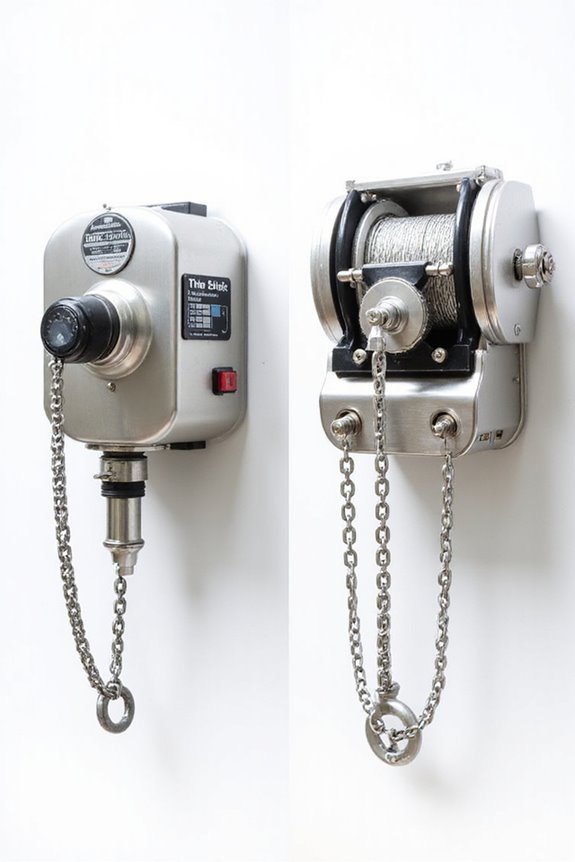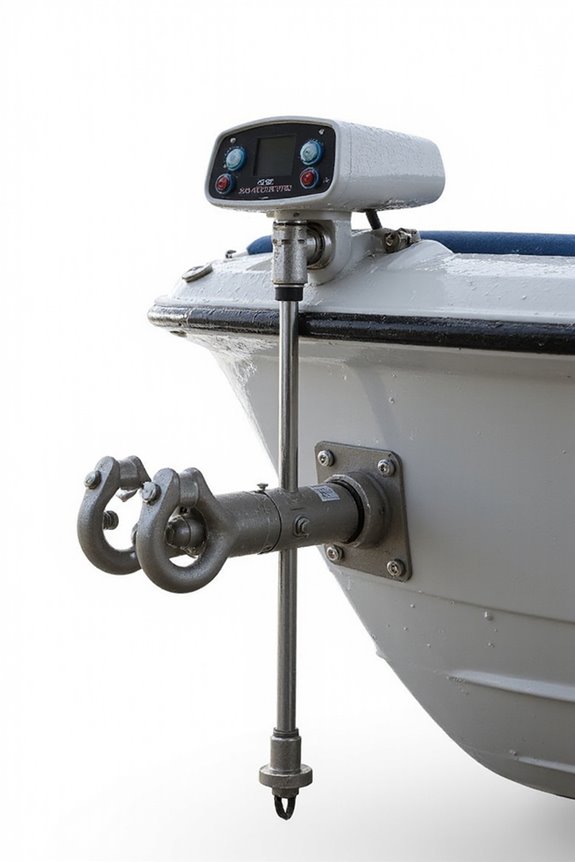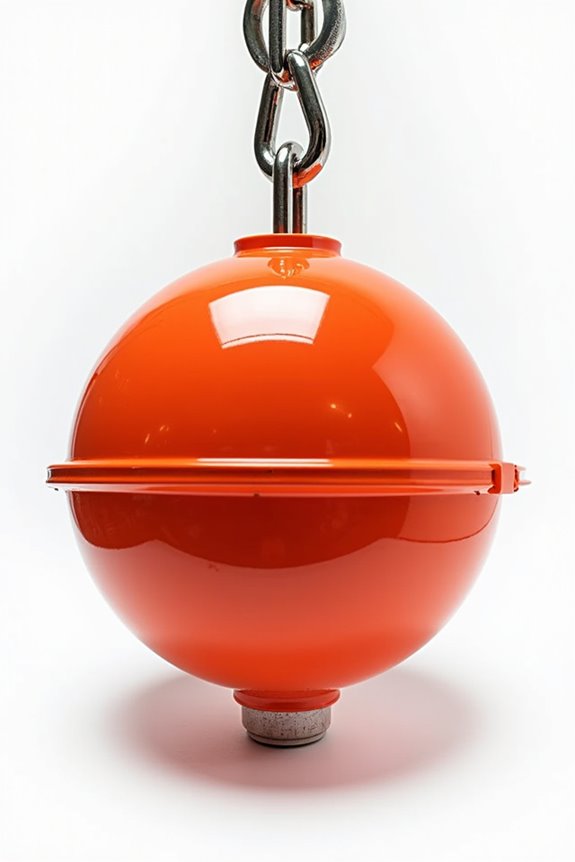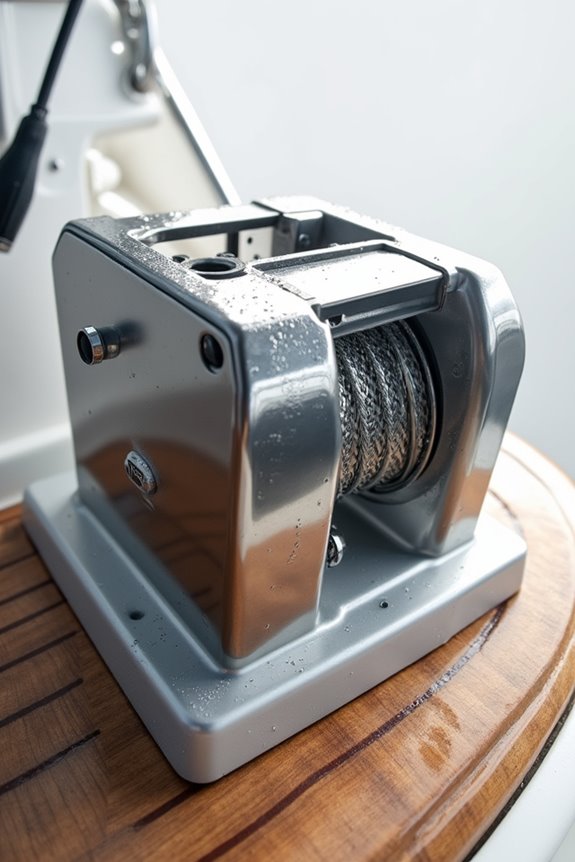Choosing between electric and manual anchor windlasses really depends on your boat size and how much elbow grease you want to put in. Manual windlasses are great for smaller boats or those who like the hands-on feel—plus, they cost less and rarely break down. But if convenience and handling heavier anchors without a sweat sound good, electric windlasses shine, though they need power and more upkeep. Curious about which fits your cruising style? Let’s explore the details.
Key Takeaways
- Manual windlasses are cost-effective, easy to maintain, and ideal for small boats or remote locations without electrical power.
- Electric windlasses offer convenience, reduced physical effort, and better handling of heavy anchors, suited for larger vessels and frequent use.
- Manual models provide tactile control and higher user engagement, while electric models prioritize ease and operational efficiency.
- Installation and maintenance costs are lower for manual windlasses, whereas electric systems require professional wiring and regular motor upkeep.
- Choosing between manual and electric depends on boat size, sailing lifestyle, budget, and preference for traditional versus modern operation.
Understanding How Manual and Electric Windlasses Work
While the idea of hauling up an anchor might sound like a workout, understanding how manual and electric windlasses actually work can make it feel a lot less intimidating. Manual operation relies on a simple mechanical design: think of a hand crank turning a central drum, wrapping the anchor chain or rope, with brakes and pawls keeping everything locked in place. It’s straightforward and reliable—kind of like the trusty old tools in a garage. Electric versions add some tech, powered by electric motors that spin the drum with just a push of a button, making life easier but adding complexity. Whether we prefer the hands-on control of manual gear or the convenience of electric, knowing these basics helps us appreciate the anchor’s journey from seabed to deck—a teamwork between man, machine, and sea.
Comparing the Initial Investment and Cost Factors
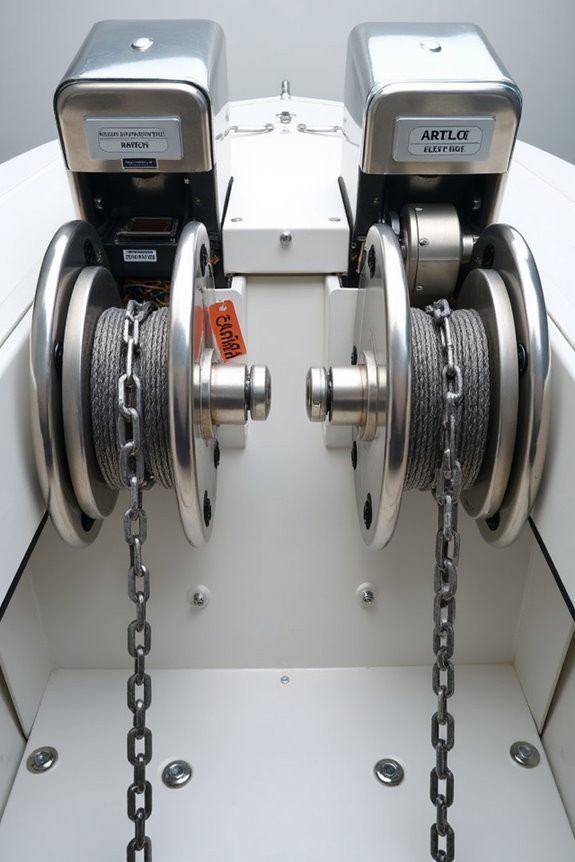
Since cost often drives our decisions as much as functionality, it’s smart to break down the initial investment and ongoing expenses between manual and electric anchor windlasses. Our cost analysis shows manual models often start around $500, making them wallet-friendly upfront, while electric versions usually run from $700 to over $1,000, especially from premium brands. Installation comparisons reveal manuals are easier and cheaper to set up—often DIY-friendly—whereas electrics demand wiring and controls that can add $500 to $750 or more in labor, plus some anchor locker tinkering. So, when you’re budgeting, think not just about sticker price but about the extras—switches, circuit breakers, maybe a remote? Manual simplicity wins initially, but electric’s convenience might justify that splurge, especially if you drop anchor frequently or on bigger boats. What matters most to you?
Maintenance Demands and Reliability Across Types
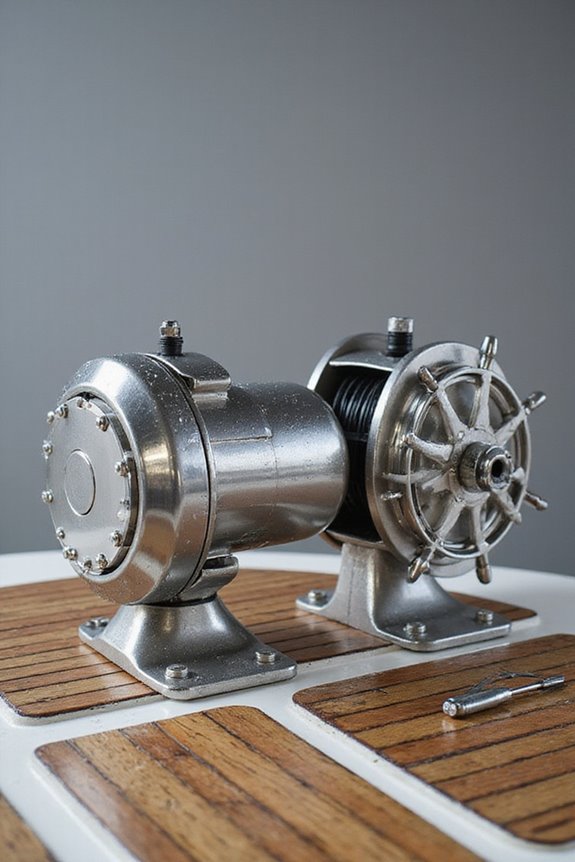
Although choosing between electric and manual anchor windlasses often boils down to cost and convenience, maintenance demands and reliability deserve a closer look before making a call. When it comes to maintenance challenges, electric windlasses require regular lubrication, motor inspections, and care for electrical connections, which can be a bit of a hassle if you’re not into routine upkeep. Manual windlasses, on the other hand, mostly need occasional greasing and chain management, making them simpler to maintain. As for reliability comparisons, electric models shine in deep water thanks to consistent power but hinge on electricity—so a dead battery means trouble. Manual windlasses might be less flashy but boast simple, robust designs that rarely fail, minus worries about electrical faults. So, are you ready to tackle some maintenance, or do you like keeping things straightforward?
Best Use Cases for Manual Windlasses
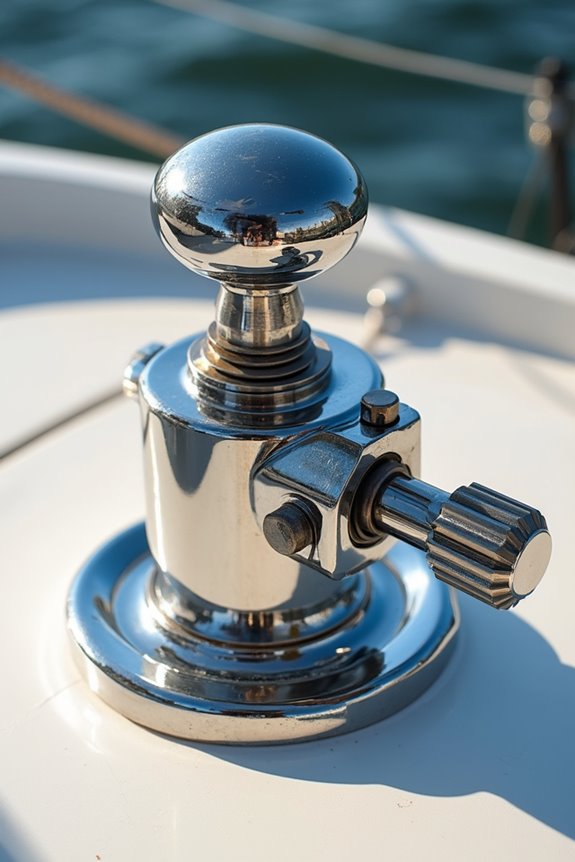
When it comes to choosing the right anchor windlass, knowing the best use cases for manual models can really help us make a smart call. Manual windlass benefits shine on small boats or short trips where electrical power is limited or simply not needed. They’re perfect for remote spots without reliable power, offering simplicity and durability without the hassle of electrical failures—kind of like the trusty old crew member who never calls in sick. Plus, their environmental impact is a big plus: since they use no electricity, they keep our carbon footprint low and embrace eco-friendly sailing. Not to mention, manual windlasses are easier to maintain, cost-effective, and reliable backups during emergencies. Additionally, multi-bottom hold features ensure that your anchor remains secure even in challenging conditions. So, if you want simplicity, control, and green credentials, manual windlasses might just be your best anchor buddy.
Advantages of Electric Windlasses for Larger Vessels
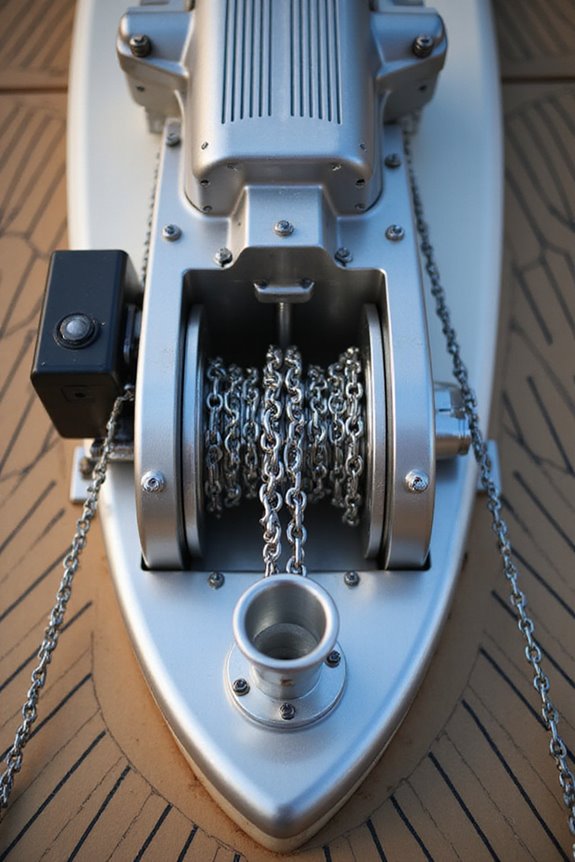
While manual windlasses have their charm and purpose, we can’t overlook the perks electric windlasses bring to larger vessels. When handling heavy anchors and chains, performance efficiency isn’t just nice—it’s essential. Electric windlasses deliver consistent, reliable power, making anchor raising and lowering smoother and less strenuous. Plus, they boost crew safety by reducing manual labor and allowing remote operation, so no one needs to stand too close to bulky, moving parts. This precise control helps maintain vessel stability, especially in rough conditions—who enjoys wrestling with an anchor in high winds? Beyond that, they’re built compact and tough, fitting well on bigger boats without hogging space. So, if we value a safer, more efficient anchoring experience, electric windlasses really do make the grade for larger vessels.
Power Requirements and Performance Capabilities
Since electric windlasses are one of the heavier power consumers on a boat, understanding their power requirements and performance capabilities is vital to keeping everything running smoothly. These devices draw between 35 and 200 amps depending on load, so knowing your boat’s battery capacity is essential. Power consumption spikes when the windlass lifts heavy loads—usually around three times the anchor’s weight—so we’ve got to factor that in to avoid draining the whole system. Performance isn’t just about strength; proper rode alignment to the waterline guarantees the windlass works efficiently without slipping, especially with chain. While electric models handle repeated or heavy use better than manual ones, they can overheat if overworked. Additionally, regular inspection of winch straps is crucial to ensure safe and effective anchoring. So, choosing the right windlass means balancing power needs with smart use and good installation.
User Experience and Operational Convenience
Understanding power needs is just one side of the story with windlasses; how we actually use them day to day makes a big difference too. When it comes to user experience, electric windlasses score high for operational efficiency—they’re faster and save us from breaking a sweat, especially if we anchor often or sail solo. But manual windlasses offer a satisfying sense of control and require less training to master. They’re perfect for smaller boats or those who enjoy the simplicity of no-electric setups. Sure, manual ones demand more physical effort, but sometimes, that’s part of the fun, right? Ultimately, weighing convenience against effort helps us choose what fits our lifestyle best. Both serve us well when maintained right; it’s about what makes our anchoring routine smoother and more enjoyable.
Safety Features and Operational Controls
Whenever we talk about anchor windlasses, safety features and operational controls are the unsung heroes keeping us out of trouble on the water. When making safety comparisons, electric windlasses shine with overload protection, automatic brakes, and thermal shut-offs—plus handy remote controls that stop the motor instantly. Manual windlasses, on the other hand, offer straightforward control mechanisms: you can’t beat the safety of just letting go to stop, no electrical glitches involved. Have you ever struggled with complicated buttons during a sudden squall? Manual’s tactile feel makes it simple and reliable, while electric systems need regular checks for wiring and battery health. So, whether you prefer tech-savvy convenience or old-school reliability, understanding these control differences keeps us all anchored in safety.
Balancing Budget, Vessel Size, and User Preferences
Though budget often steals the spotlight when choosing an anchor windlass, it’s only one piece of the puzzle alongside vessel size and what you personally prefer. Finding the right balance means aligning your budget with your boat’s needs and your style of sailing. Smaller boats often do well with manual windlasses—friendly on the wallet and great for user engagement without relying on electrical power. Larger vessels, however, usually call for electric models to handle heavier anchor loads effortlessly, even if that means a higher initial investment and some extra upkeep. Additionally, ensuring that your equipment is corrosion-resistant and durable is vital for longevity, especially in marine environments. So, are you keen on simplicity and a quiet anchor drop, or do you prefer the convenience that spares your arms? Together, we’ll weigh these factors, ensuring your anchor system matches your budget alignment and sailing lifestyle perfectly.
Frequently Asked Questions
Can Manual Windlasses Be Upgraded to Electric Without Replacing the Entire Unit?
We’ve found upgrade options that let us convert manual windlasses to electric without replacing the whole unit. But installation considerations like tools, space, and electrical knowledge mean we might want help or careful planning to succeed.
How Do Windlasses Affect Boat Resale Value?
Did you know boats with well-maintained windlasses see up to a 15% resale impact? Together, we can boost value retention by keeping these systems functional, making our vessels more appealing and valuable in today’s market.
Are There Hybrid Manual-Electric Windlass Models Available?
We’ve explored windlass technology, and while true hybrid models combining manual and electric functions aren’t common, some windlasses feature hybrid gypsy designs that enhance strength and versatility—great options for those of us wanting reliable, adaptable gear onboard.
What Warranties Typically Cover Electric Versus Manual Windlasses?
When it comes to warranty limitations, we find electric windlasses often have broader coverage but require stricter maintenance. Manual models offer simpler warranties focusing on mechanical parts, so understanding maintenance differences helps us keep our warranties valid together.
How Does Windlass Choice Impact Emergency Anchor Deployment Procedures?
Did you know electric windlasses can speed anchor deployment by up to 50%? Together, we boost emergency preparedness and deployment efficiency, ensuring we’re ready and safe when it matters most—because we’re stronger working as one crew.

